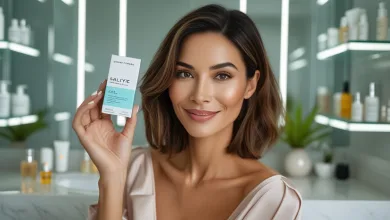How to Create an Effective Acne Treatment Routine

Struggling with stubborn acne? You’re not alone. Creating an effective acne treatment routine doesn’t have to be complicated. This comprehensive guide breaks down the essential steps, ingredients, and habits that will help you achieve clearer skin, based on dermatologist recommendations and scientific research.
Understanding Your Skin: The Foundation of Any Effective Acne Treatment Routine
Let’s face it — dealing with acne can be a real pain in the neck! Whether you’re battling occasional breakouts or persistent pimples, understanding your unique skin is the first crucial step in creating an effective acne treatment routine that actually works.
Acne develops when your skin’s oil glands produce excess sebum, which combines with dead skin cells to clog pores. Bacteria called Propionibacterium acnes can then multiply in these clogged pores, leading to inflammation and those pesky pimples we all dread. But here’s the thing — not all acne is created equal, and what works for your bestie might not work for you. That’s why identifying your skin type (oily, dry, combination, or sensitive) is absolutely essential before diving into any treatment regimen.
“Understanding your skin type is like having a roadmap for your acne treatment journey,” says Dr. Jennifer Lee, a board-certified dermatologist from Los Angeles. “Without knowing what you’re working with, you’re essentially throwing darts in the dark.”
The Essential Steps of an Effective Acne Treatment Routine
1. Gentle Cleansing: The First Line of Defense
Oh boy, cleansing is where the magic begins! But don’t go scrubbing your face like you’re trying to remove permanent marker. A gentle touch is key here.
Washing your face twice daily with a mild, pH-balanced cleanser removes excess oil, dirt, and sweat that can contribute to breakouts. For oily and acne-prone skin, look for cleansers containing salicylic acid, which penetrates oil-filled pores and exfoliates from within. If you’ve got sensitive or dry skin, opt for gentler formulations with soothing ingredients like ceramides or glycerin.
“The biggest mistake I see patients make is overwashing or using harsh cleansers that strip the skin,” explains Dr. Sarah Mitchell, dermatologist and researcher at Stanford University. “This actually triggers your skin to produce more oil as a defense mechanism, creating a vicious cycle.”
When cleansing, use lukewarm water (hot water can irritate and dry out skin) and pat — don’t rub — your face dry with a clean towel. Remember: cleansing sets the stage for everything that follows in your effective acne treatment routine, so don’t rush this step!
2. Exfoliation: Clearing the Path for Better Absorption
Alright, let’s talk about exfoliation — your secret weapon against those stubborn dead skin cells that love to clog pores!
There are two main types of exfoliants to consider:
- Chemical exfoliants: These include alpha-hydroxy acids (AHAs) like glycolic acid and beta-hydroxy acids (BHAs) like salicylic acid. BHAs are particularly effective for acne-prone skin because they’re oil-soluble, allowing them to penetrate deeper into pores.
- Physical exfoliants: These scrubs contain tiny granules that physically remove dead skin cells. While they can be effective, they’re often too harsh for active acne and may cause irritation and micro-tears in the skin.
For most people with acne, chemical exfoliants are the safer bet. Start by exfoliating just once or twice weekly, then gradually increase frequency as your skin builds tolerance. Over-exfoliation can damage your skin barrier and actually worsen acne, so more isn’t always better!
“The goal of exfoliation isn’t to feel a tingling sensation or see redness — that’s irritation, not effectiveness,” says cosmetic chemist Ginger King. “Proper exfoliation should leave your skin feeling smooth, not stripped or irritated.”
Targeted Treatments: The Heavy Hitters in Your Acne Arsenal
Now we’re getting to the heart of your effective acne treatment routine — the treatments that directly target those annoying breakouts.
1. Benzoyl Peroxide: The Bacteria Fighter
Benzoyl peroxide is one of the most effective over-the-counter ingredients for acne, working by killing the P. acnes bacteria that contribute to inflammation. It’s particularly effective for inflammatory acne (those red, painful pimples) and comes in concentrations ranging from 2.5% to 10%.
Interestingly, studies have shown that higher concentrations don’t necessarily work better but can cause more irritation. A 2.5% benzoyl peroxide formulation can be just as effective as 10% with fewer side effects. Start with a lower concentration and use it once daily, gradually increasing as needed.
The downside? This stuff can bleach fabrics, so be careful around colored towels and pillowcases!
2. Retinoids: The Cell Regulators
If I had to pick a MVP in the acne treatment game, retinoids would definitely be in the running! These vitamin A derivatives normalize skin cell turnover, preventing the clogging of pores that leads to acne.
Over-the-counter options like adapalene (Differin) are now available without a prescription, making this powerful ingredient more accessible than ever. For more severe acne, prescription-strength retinoids like tretinoin or tazarotene might be necessary.
“Retinoids are the gold standard for both treating and preventing acne,” explains Dr. Emma Wedgeworth, consultant dermatologist and spokesperson for the British Skin Foundation. “They work not just on active breakouts but also on the micro-comedones that haven’t yet reached the surface.”
When starting a retinoid, the “low and slow” approach is best — begin with a pea-sized amount 2-3 times weekly, and gradually increase frequency as your skin adjusts. Retinoids can cause dryness and sensitivity, particularly in the first few weeks, so patience is key!
3. Spot Treatments: The Emergency Response Team
Let’s be real — sometimes a surprise pimple pops up right before an important event, and you need immediate action. That’s where spot treatments come in handy!
Effective spot treatments often contain higher concentrations of acne-fighting ingredients like sulfur, salicylic acid, or benzoyl peroxide. Apply these only to active breakouts, not all over your face. For overnight emergencies, hydrocolloid patches (those little round stickers) can work wonders by absorbing fluid and reducing inflammation.
Remember though, spot treatments should be exactly that — for spots! They’re not a replacement for a consistent, effective acne treatment routine.
Hydration and Protection: The Often Overlooked Heroes
1. Moisturizing: Yes, Even for Oily Skin!
I know what you’re thinking — “Moisturizer? For my already oily, acne-prone skin? No way!” But hold up! Skipping moisturizer is one of the biggest mistakes in any acne treatment routine.
Many acne treatments can be drying and irritating. Without proper hydration, your skin might compensate by producing even more oil, creating a counterproductive cycle. The trick is finding the right moisturizer for your skin type:
- For oily skin: Look for lightweight, oil-free, non-comedogenic gel moisturizers
- For combination skin: Consider using different products on different areas of your face
- For dry, acne-prone skin: Creamier formulations with ceramides can help repair the skin barrier
“The skin’s barrier function is crucial for healthy skin, and moisturizing helps maintain this function,” says Dr. Joshua Zeichner, Director of Cosmetic and Clinical Research in Dermatology at Mount Sinai Hospital. “Even acne-prone individuals need to hydrate their skin properly.”
2. Sunscreen: The Non-Negotiable Step
Sunscreen isn’t just about preventing wrinkles — it’s an absolute must in any effective acne treatment routine. Many acne treatments (especially retinoids) increase sun sensitivity, making your skin more vulnerable to UV damage. Plus, sun exposure can darken post-acne marks, prolonging the appearance of breakouts even after they’ve healed.
Look for broad-spectrum, oil-free sunscreens labeled “non-comedogenic.” Newer formulations with zinc oxide or titanium dioxide are often well-tolerated by acne-prone skin and don’t leave that ghostly white cast of older sunscreens.
Apply sunscreen every morning as the final step in your skincare routine (before makeup, if you wear it), and reapply throughout the day if you’re spending time outdoors.
Lifestyle Factors That Complement an Effective Acne Treatment Routine
Your skincare products are just one piece of the puzzle. These lifestyle factors can make or break your acne treatment success:
Diet and Hydration: Feeding Your Skin from Within
The connection between diet and acne has been debated for decades, but recent research suggests there may indeed be links between certain foods and breakouts. Studies have found associations between acne and:
- High-glycemic foods (white bread, sugary snacks, etc.)
- Dairy products, particularly skim milk
- Whey protein supplements
While the research isn’t conclusive enough to make blanket recommendations, many dermatologists suggest experimenting with an elimination diet if you suspect certain foods trigger your breakouts.
Drinking adequate water is another simple but effective way to support your skin’s health. While water alone won’t clear acne, proper hydration helps your body’s natural detoxification processes and maintains skin barrier function.
Stress Management: Your Skin’s Emotional Health
Ever notice how pimples seem to appear right before big events? That’s no coincidence! Stress triggers the release of hormones like cortisol that can increase oil production and inflammation in the skin.
Incorporating stress-reduction techniques into your routine — whether it’s meditation, exercise, adequate sleep, or simply taking breaks from screens — can make a surprising difference in your skin’s appearance. Some patients find that stress management is just as important as the products in their effective acne treatment routine!
“The mind-skin connection is powerful,” notes Dr. Richard Fried, a dermatologist and psychologist specializing in psychodermatology. “Stress reduction techniques can measurably improve inflammatory skin conditions like acne.”
Creating Your Personalized Acne Treatment Routine
Now that we’ve covered the essentials, let’s put everything together into a simple framework for morning and evening routines:
Morning Routine:
- Cleanse with a gentle face wash
- Apply any water-based treatments (like vitamin C serum)
- Moisturize with a lightweight, non-comedogenic formula
- Finish with broad-spectrum sunscreen (SPF 30 or higher)
Evening Routine:
- Double cleanse if you wear makeup or sunscreen (first with an oil-based cleanser, then with your regular cleanser)
- Apply active treatments (retinoids, benzoyl peroxide, etc.)
- Moisturize generously
- Spot treat as needed
Remember, consistency is key when establishing an effective acne treatment routine. Most dermatologists recommend giving any new routine at least 6-8 weeks before evaluating its effectiveness or making changes.
Troubleshooting: When Your Acne Treatment Isn’t Working
If you’ve been diligently following your routine for two months and aren’t seeing improvement, it might be time to:
- Evaluate product interactions: Some ingredients cancel each other out when used together. For example, benzoyl peroxide can deactivate retinoids if applied simultaneously.
- Check your application order: As a general rule, apply products from thinnest to thickest consistency.
- Consider a professional consultation: Dermatologists can prescribe stronger treatments and identify underlying issues that might be contributing to your acne.
“If over-the-counter products aren’t working after 6-8 weeks of consistent use, that’s a sign you might need prescription-strength interventions,” advises Dr. Shereene Idriss, a board-certified dermatologist in New York City. “Don’t waste years trying product after product when professional help could save you time, money, and emotional distress.”
Frequently Asked Questions About Acne Treatment Routines
How long does it take to see results from a new acne treatment routine?
Most dermatologists recommend giving your routine at least 6-8 weeks before evaluating its effectiveness. Acne develops deep within the skin, and it takes time for treatments to work and for your skin’s natural renewal cycle to bring improvements to the surface. In the first few weeks, you might even experience “purging,” where acne seems to worsen before it gets better.
Can I use multiple active ingredients in my routine?
Yes, but with caution! Some ingredients like retinoids and benzoyl peroxide can deactivate each other, while others can cause excessive irritation when used together. A good approach is to use different actives at different times (e.g., vitamin C in the morning, retinoid at night) or on alternate days.
Is it normal for my skin to get worse before it gets better?
This phenomenon, often called “purging,” can occur with ingredients that increase cell turnover (like retinoids). What’s happening is that existing clogged pores are pushing their contents to the surface more quickly. True purging should occur in areas where you normally break out and resolve within 4-6 weeks. If you’re experiencing irritation or breakouts in new areas, that’s likely a reaction, not purging.
Do I need expensive products for an effective acne treatment routine?
Absolutely not! While some premium products contain beneficial proprietary ingredients, the core active ingredients (benzoyl peroxide, salicylic acid, retinoids) are available in affordable drugstore options. The consistency of your routine matters far more than the price tag of your products.
How do I deal with acne scars as part of my treatment routine?
For post-inflammatory hyperpigmentation (dark spots), ingredients like vitamin C, niacinamide, and tranexamic acid can help fade discoloration. For textured scarring, professional treatments like microneedling or laser therapy are often necessary. In any case, preventing new breakouts through an effective acne treatment routine is the first step in managing scarring.
Wrapping Up: Your Journey to Clearer Skin
Creating an effective acne treatment routine isn’t about finding a magical product that solves everything overnight. Instead, it’s about understanding your unique skin, consistently applying science-backed treatments, and having patience as your skin heals.
Remember that your skin’s needs may change with seasons, hormonal fluctuations, or lifestyle changes. Being adaptable and willing to adjust your routine accordingly is part of the process. With persistence and the right approach, clearer skin is absolutely achievable!
The journey might not always be linear — there will likely be setbacks and breakthroughs along the way. But armed with the knowledge in this guide, you’re well-equipped to create an effective acne treatment routine that works specifically for you. Here’s to your path toward healthier, clearer skin!






